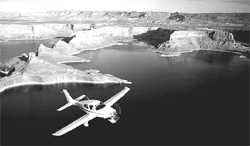Parachutes to the rescue
 when a damaged aircraft goes out of control in mid-air, the last resort is to jump out of the plane with a parachute. But this can be quite difficult at times. It is by no means easy to jump out of a spinning aircraft. Cirrus Design, a us company based in Duluth, Minnesota, which manufactures the sr 20 light aircraft, has come out with the first plane to have a built-in parachute system that allows damaged planes to be lowered to safety ( New Scientist , Vol 162, No 2180).
when a damaged aircraft goes out of control in mid-air, the last resort is to jump out of the plane with a parachute. But this can be quite difficult at times. It is by no means easy to jump out of a spinning aircraft. Cirrus Design, a us company based in Duluth, Minnesota, which manufactures the sr 20 light aircraft, has come out with the first plane to have a built-in parachute system that allows damaged planes to be lowered to safety ( New Scientist , Vol 162, No 2180).
It works at an altitude of less than 300 metres, even when the aircraft is in full spin, allowing the plane to land the right way up. As the plane touches down at a speed of about 27 kilometres per hour (km/h), it uses the landing gear to absorb the shock. The plane is damaged but the passengers and the fuselage remains intact.
The parachute is released by pulling a lever, which fires a rocket from the rear of the fuselage. This takes the chute to a safe distance while it is still in its bag. An ordinary parachute opens right after the release. While this is okay at low speeds, at high speeds the load force is so great that the chute does not work. "The force would tear it to shreds,' says Paul Johnston, chief engineer on the project to develop the parachute.
In order to handle this, the parachute uses a cloth slider to control the rate at which it opens. This lets air into the canopy at a regulated speed, so the aircraft slows down even before the chute is open fully.
The chute is connected to the plane by means of three straps: one from the rear of the plane and two from the front of the fuselage. The two front straps run along the side of the vehicle, and are moulded into the fuselage during manufacture. On being released, they get ripped out of the casings, which are discarded. Rae Willis, a pilot from Morristown in New Jersey who has flown light aircraft for 40 years, points out pilots are most likely to go into a spin below 300 metres as they turn into their final approach. "The key is that it is a last resort, which is probably of more use at higher altitudes. Yank the handle and cross your fingers,' he says.
The company has received more than 250 advance orders.
